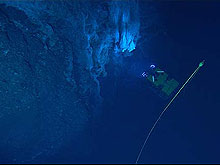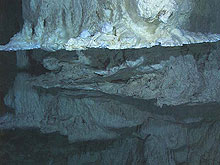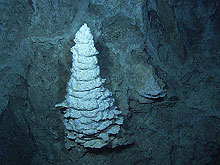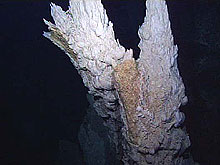
Sample of images taken by Hercules and Argus. Image courtesy of IFE, URI-IAO, UW, Lost City science party, and NOAA.
ROV Argus captures an image of the ROV Hercules dwarfed by the IMAX tower. Click image for larger view and image credit.
Images
July 30, 2005
Dr. Deborah Kelley
Co-chief Scientist
![]() Video
of the IMAX Flange (Quicktime, 1.1 Mb)
Video
of the IMAX Flange (Quicktime, 1.1 Mb)
![]() Video
of the Beehive (Quicktime, 816 Kb)
Video
of the Beehive (Quicktime, 816 Kb)
![]() Video
of Marker 7 (Quicktime, 1.1 Mb)
Video
of Marker 7 (Quicktime, 1.1 Mb)
As we near the end of the cruise, we realize what remarkable views of the field the coupling of Hercules and "the eye in the sky" Argus has provided us. This technology has sent us fascinating, highly detailed imagery of the main chimneys within Lost City. From this we have gained a new understanding of the geometry of the system, the spectacular and diverse shapes that the chimneys form during their 30,000-year evolution, and the shear cliffs on which the field is perched. Here are some of the great images we will remember:
 IMAX Flange
IMAX Flange
Dr. Deborah Kelley
The IMAX flange sprouts like an inverted stalagmite from the side of the 200-foot tall massive edifice called Poseidon. IMAX is one of the most beautiful structures within the Lost City Field, gracefully rising 3 stories in height above the flanges at its base. The friable, scalloped flanges were first sampled on the initial discovery dive into the field with the 3 person submersible Alvin in 2000. The flanges trap pools of 55 degree C fluids that form reflecting pools at the interface between the warm hydrothermal vent fluid and cooler seawater. interface is reminiscent of a reflecting lake surface on a very calm day, with gentle ripples formed by leaking of hydrothermal fluids out of the main trunk of Poseidon. Sampling of this structure shows that IMAX is made out of the calcium carbonate minerals aragonite and calcite (CaCO3), and the magnesium-rich mineral called brucite [Mg(OH)2]. The porous warm interior of this flange is saturated in very high pH fluids, rich in methane and hydrogen, but absent in oxygen. High densities of methane- metabolizing microorganisms related to the phylotype Methanoscarcinales thrive within this extreme environment. Based on genetic analyses, some of the closest "relatives" of these organisms live in sediments along the continental margins associated with methane seeps. During this expedition IMAX was imaged intensely and sampled so that we can better understand how old it is, how these structures evolve through time, and the novel microorganisms that call it home.

This delicate flange actively vents heated hydrogen and methane rich fluids. Click image for larger view and image credit. (HR)
![]() Video
of the IMAX Flange (Quicktime, 1.1 Mb)
Video
of the IMAX Flange (Quicktime, 1.1 Mb)
 The Beehive
The Beehive
Dr. Gretchen Fruh-Green
Geologist
The carbonate chimney that we christened Beehive is one of our favorite places and is perched precariously in the middle of a steep wall on the north side of the Poseidon complex. It is a small structure, shaped like a Christmas tree or a beehive, and is a spectacular example of how diverse the structures at Lost City are in size and shape. The structure was sampled extensively in 2003, and we were very excited to see that everything had grown back and now stands over one meter (three feet) high - a pixie compared to the towering 60 meter (180 feet) height of Poseidon.
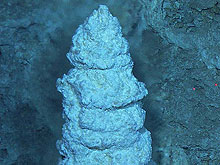
Close-up view of the Beehive. Click image for larger view and image credit.
![]() Video
of the Beehive (Quicktime, 816 Kb)
Video
of the Beehive (Quicktime, 816 Kb)
The results of the 2003 cruise showed that the 91°C (195°F) fluids coming out at Beehive have the highest temperatures and are the most vigorously venting fluids found in the Lost City field. These fluids also have chemical compositions that define the purest, or end-member, hydrothermal compositions. The re-growth of Beehive between 2003 and 2005 not only serves as a valuable growth experiment, but also allows us to examine the very first material that is formed in these highly alkaline systems. The biologists and geomicrobiologists in our science team can examine this newly precipitated material to determine which organisms live in these extreme environments and how they participate in chimney growth. During this expedition we sampled the Beehive fluids again and our chemical and isotopic analyses will allow us to see if, and how, the chemical compositions may have changed within the past two years. Sampling the rocks, fluids and biology in active hydrothermal systems over time spans of many years truly gives scientists an invaluable tool to study how hydrothermal systems change with time and how these changes affect the organisms that have learned to survive in these severe conditions.
Bright white antlers of Marker 7. Click image for larger view and image credit.
![]() Video
of Marker 7 (Quicktime, 1.1 Mb)
Video
of Marker 7 (Quicktime, 1.1 Mb)
 Marker 7
Marker 7
Kristin Ludwig
Geologist
Ph.D student
Marker 7 is located on the east side of the field. At its base, there are 5 distinct "trunks" of carbonate chimneys, growing directly from the serpentinite bedrock. The tallest two of these chimneys are melded together at the top, terminating in a delicate, bright white antler-like formation of two carbonate cones. Diffuse venting is observed in the saddle between these two spires.
On the southeast side of this structure is a smear of dark discoloration, which may indicate older, weathered carbonate coated with manganese oxide. As a whole, the structure towers ~20 m above the seafloor. A notable wall rises steeply from behind the Marker 7 structure. This shear face of serpentinite features pods or bowl-like formations of carbonate growing directly from the near vertical to overhanging face. Nearly 100m behind the Marker 7 pinnacles is a graceful spire, a ~10m snow white structure growing directly from the carbonate wall. There is no visible venting from this column, but it does appear to be relatively young and host fresh carbonate.
Sign up for the Ocean Explorer E-mail Update List.



























